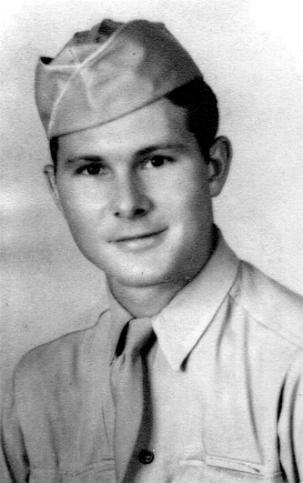

Grimm Was Held Prisoner In Stalag XIIIC During WWII

CLIFTON — (Gloria M. Hewlett has been collecting the stories of
Bosque County veterans for a book that she is compiling. This is the
38th in a series of the stories she has given to The Record for
publication.)
Cpl. Furman Grimm was born in Clifton to Mr. and Mrs. Enor Grimm.
After finishing high school in Clifton in 1939, he entered the
University of Texas at Austin.
Shortly after the Japanese bombed Pearl Harbor, he joined the Army
Enlisted Reserve Corps, and was called into active service in early
1943.
From Fort Sam Houston, Grimm was sent to the “Jap Trap” (a section
of Camp Maxey at Paris, Texas, that was intended for detention of
Japanese prisoners of war), however, very few were ever captured so the
area was used by the 8th Service Command’s ASFRTC for basic training.
After completing basic training, Grimm entered the University of
Arkansas at Fayetteville, where he enrolled in an advanced phase of
civil engineering. This became known as the Army Specialized Training
Program. In addition to engineering curriculums, foreign languages,
dentistry, and medicine were offered.
The program was abruptly cancelled in early 1944, and more than
100,000 trainees were reassigned to infantry, armored, and airborne
divisions. Grimm found himself back at Paris, where he joined the 99th
Infantry Division. After a brief training period, the Division was moved
to the Boston area, where they staged for the European Theater of
Operations.
The trip over the North Atlantic on the USS Explorer in a convoy
was extremely rough, and not without anxious moments. A zigzag course
was taken to avoid German U-Boats.
The ship docked at Glasgow, Scotland, and the division was moved by
rail to the south of England. Final staging and preparations for combat
were completed by early fall. It was necessary to cross the English
Channel in LCMs so that landings could be made on the beaches near
LeHavre, France.
After wading ashore through the wreckage of landing crafts and
equipment, it became apparent that it had taken a massive effort and the
loss of many lives to secure the beaches of France. This was the
beginning of the Battle of the Bulge.
The Division moved through French and Belgium to an area where
defensive positions were made along the border of Germany and Belgium.
Other than sporadic mortar fire, overhead whining of enemy V-1 buzz
bombs, and nighttime patrols, the area was considered a “quite” sector.
However, the company commander was killed on one of the earlier patrols
and several, including a good friend of Grimm’s, sustained war-ending
injuries.
A lack of intelligence and heavy overcast skies allowed the enemy
to gather the last of their troops and push toward Antwerp where they
hoped to split the American and British forces. The brunt of the German
attack occurred near U.S. thinly-manned positions.
A few days before the 16th of December, 1944, the company was moved
off the front lines to a reserve position. Showers, clean and suitable
clothing for heavy snow, hot food, and, if lucky, an opportunity to see
Marlene Dietrich, was in the offering. This never happened.
On the morning of Dec. 16, the Germans unleased an artillery
barrage that seemed to last for an eternity. Since Grimm’s company was
in a former German training area, the German’s 88s were incredibly
accurate.
After much confusion and incorrect intelligence, the company was
somehow able to hold the position the balance of the day. German Mark IV
tanks followed by assault troops and air support overran the U.S. lines
on Dec. 17.
On the morning of Dec. 18, the company, along with Regiment,
withdrew, leaving a number of men out on perimeter ground without being
alerted.
When the men realized they had been left behind, several of them
went into a small town where cover was taken in the basement of a home.
Later in the day, the men, including Grimm, were discovered and taken
prisoner.
Suffice it to say, life as a POW for 4½ months in Stalag XIII C,
Hamelburg, is another story.
Liberation by the 45th Infantry Division came the last day of May
1945 in the town of Wendlestein, near Nuremburg. After being flown to
Camp Lucky Strike in France, Grimm and the other POWs were given
immunization shots, deloused, given medical exams, and showered with
soap.
The return home on the hospital ship, the USS George Washington,
and news of Germany’s unconditional surrender, increased moral. Then
seeing the Statue of Liberty at the entrance to New York Harbor, made a
perfect ending to the voyage.
Six weeks of rehabilitation at Hot Springs, Ark., and later a tour
of duty as a cadreman at Camp Fannin, followed for Grimm. He was
discharged from the Army in November 1945.
After graduation from the University of Texas at Austin in 1946,
Grimm was employed as a geophysicist with the Humble Oil Refining
Company (Exxon).
Grimm married Frances Bronstad in 1948, and two sons were born to
this union, Steven and Michael. His employment as a geophysicist took
the family to Los Angeles, Calif.; Roswell, N.M.; Midland, Texas; and
Southeast Asia. He retired as Exxon’s USA manager of geophysics.
After retirement from Exxon, Grimm managed a stock farm north of
Meridian, and after retiring fully in 1980, the family moved to Clifton,
where they resided for 20 years. The Grimm’s recently moved to Temple.
Donated by: Edward L. Williams
|
County Coordinator:
Gayle Triller
|